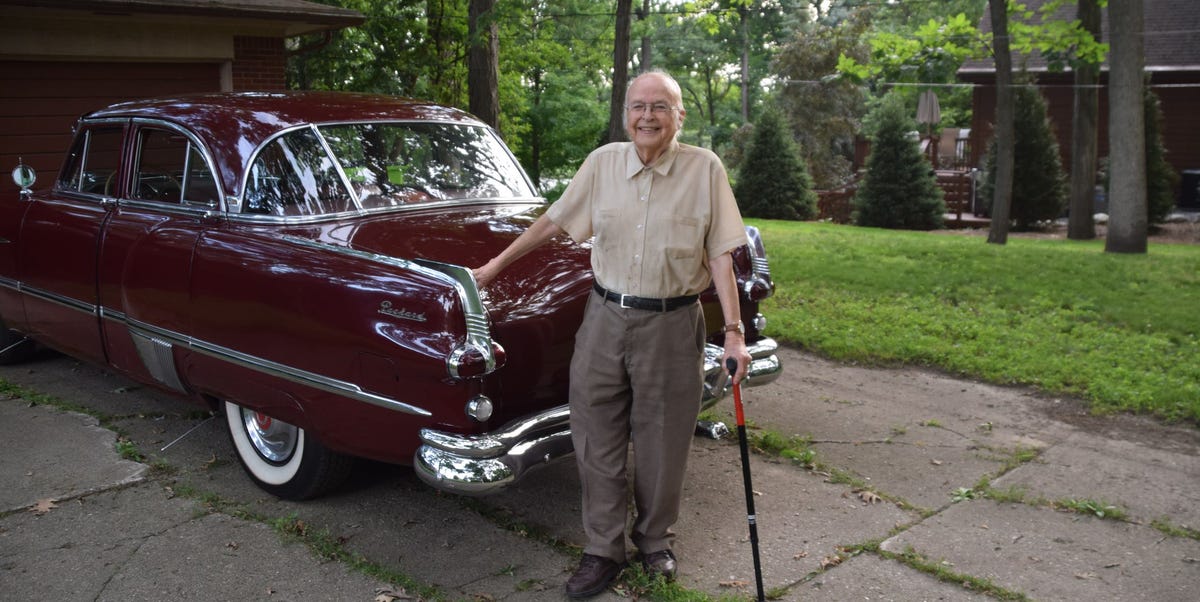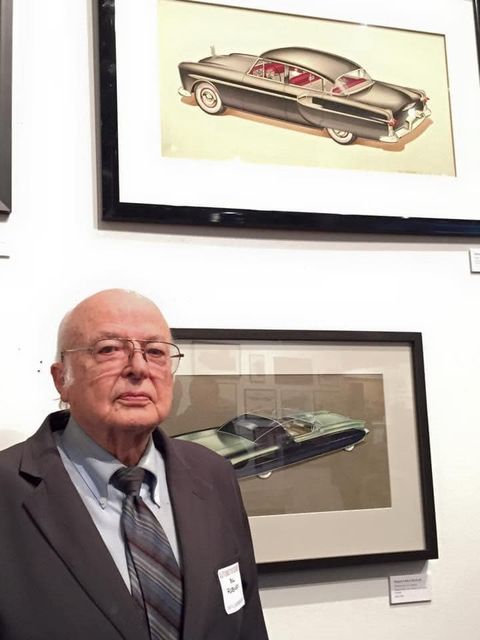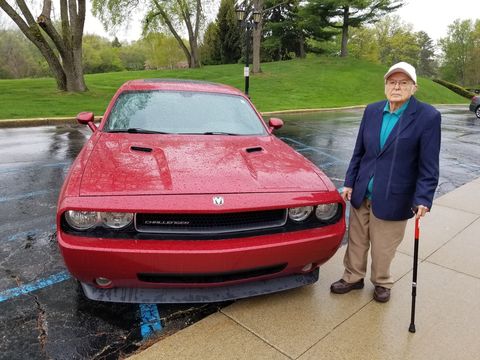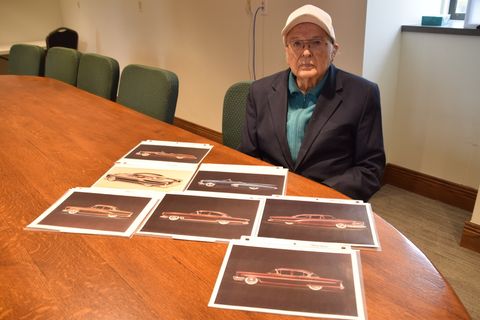Influential Automotive Designer, Teacher Bill Robinson Dead at 96

- Bill Robinson’s automotive design career began in 1948 and included stints at Kaiser-Frazer, Briggs Mfg. (working on Packards), and Chrysler.
- Robinson taught “every car designer to come out of the College of Creative Studies (CCS) in the 1980s and ‘90s. It’s not hyperbole. He literally designed the design community,” Rivian’s Richard Vaughan said.
- Kirk in the Hills Presbyterian Church in Bloomfield Township, Michigan, will host a memorial service March 4.
Automotive designer Bill Robinson, who penned Packards in the 1950s and later educated a generation of automotive stylists shaping today’s vehicles, died Tuesday at a hospital in Pontiac, Michigan. He would have celebrated his 97th birthday in August.
“As one of the thousands of industrial designers Bill Robinson looked after during his time as our transportation design instructor at the College for Creative Studies (in Detroit), I can tell you that he was not only our instructor but also our mentor, our coach, and ultimately our friend decades after graduation,” said Ralph Gilles, Stellantis’ chief design officer.
Gilles will remember Robinson as a class act and a car enthusiast to the core who enjoyed racing on Woodward Avenue in Detroit as a young man. As recently as a few months ago, Robinson was still driving his Dodge Challenger SRT Hellcat in suburban Detroit.
Growing up on the east side of Detroit, Robinson was drawn to automotive design at a young age. One of his neighborhood friends was the son of Vincent Kaptor, who was a top assistant to General Motors design chief Harley Earl. Robinson remembered Kaptor bringing home a spectacular, luxurious white Cord that he was evaluating for work in the 1930s.
“That car broke up our ball game because we just stood and stared at it,” Robinson said in an interview last year. “The price of that car was $2400 at a time when you could buy most cars for $1000.”
At age 13, Robinson won the best design award for his soapbox derby racer that incorporated an adjustable suspension and a windshield. He attended Denby High School in Detroit for two years and then transferred to Cass Tech High School downtown for its product design curriculum. While in high school, he learned how to illustrate cars from a veteran designer who worked on catalogs with oil paint.
After graduating, he wanted to attend art school and began building a portfolio of his drawings.
He applied for a job at the Sundberg-Ferar design house in Detroit and intended to work there a few years, then attend art school.
“They told me, ‘You don’t have to do that because this is the best portfolio we’ve ever seen,’” Robinson recalled. He declined that offer but instead took a job illustrating advertising brochures in 1948 before landing his first automotive design job at Kaiser-Frazer in 1948, where he designed early-stage proposals for 1950s Packards.
After a few years, he moved to Briggs Mfg. Co. (a contract automotive body producer), where he worked more directly on forthcoming Packard models. At Briggs, Robinson designed the back end of the 1953 Packard Patrician, the brand’s flagship sedan. Robinson’s father worked at the Packard plant for 25 years, and the family owned six Packards.
Chrysler eventually purchased Briggs, and Robinson went on to pen the 1954 Plymouth Belmont concept car and contributed heavily to the 1957 Plymouths, most notably the Fury. Plymouth sold 750,000 cars in 1957, and Robinson was proud to take some of the credit for his design contributions.
He worked until the early 1980s on dozens of production Chrysler group vehicles—his last being the Plymouth Horizon and Dodge Omni. He attended more than 200 wind-tunnel tests in Maryland to achieve the proper aerodynamic profile for the compact cars. (See video below of Robinson talking about his career.)
This content is imported from YouTube. You may be able to find the same content in another format, or you may be able to find more information, at their web site.
After retiring from Chrysler, his next chapter began: teaching transportation design at Detroit’s then-named Center for Creative Studies. It was a natural fit because as he gained experience at Chrysler, he spent a lot of time grooming younger designers.
“Bill’s greatest impact on me as his student was opening my eyes to the major effects that proportion makes on vehicle design,” said Mark Allen, head of Jeep Design at Stellantis. “Before that, I was overly focused on the details and not enough on the foundational elements like wheel and glass placement, overhangs and how the design reacts to slight alterations in the ingredients.”
As a mentor, Allen said Robinson was “gifted in how he could deliver a stinging, soul-crushing critique of your work in the absolutely kindest, grandfatherly way, always. He was careful to deliver comments on the work, not the author. Bill’s teachings remain at the root of how I operate today and for that I will always be thankful to have had the privilege to study under his guidance.”
Another CCS student of Robinson’s, Richard Vaughan, worked previously as a designer at Visteon and now is director of design quality at EV producer Rivian,
Seeing a 1953 Patrician cruising Woodward in suburban Detroit, Vaughan said, “My first thought was, ‘Wow, look at that Bill Robinson Packard.’”
Vaughan said Robinson’s influence on car design cannot be overstated as every automaker today has designers who studied under him.
“I strongly believe that Bill Robinson is the most influential American car designer of the post-war era,” Vaughan said. “Not because he designed the most famous or most beautiful cars, but because he taught every car designer to come out of CCS in the 1980s and ‘90s. It’s not hyperbole. He literally designed the design community. Every design executive working today who was at CCS in that time owes something to Bill and we all adore him.”
William Chergosky, chief interior designer at Toyota’s CALTY Design Research center in California, said Robinson taught with authority, from years of industry experience.
“At CCS, Bill had a soft hand sharing that wisdom that allowed uncomfortable innovation to take root and grow,” Chergosky said. “His generous heart and mind gave me insight into how to guide young artists without stifling their creativity. Bill was truly a one-of-a-kind gentleman and designer.”
Robinson never married. His only brother preceded him in death many years ago. But he did not die alone.
He had suffered a stroke after falling in his garage recently and was visited daily in the hospital by friends from Kirk in the Hills Presbyterian Church in Bloomfield Township, where Robinson taught Bible school for decades. The church has a pastoral residency program named for him.
Kirk in the Hills will host a memorial service at 11 a.m. March 4, and Robinson has specified memorial donations be made to The Good Shepherd Orphanage in Haiti.
This content is created and maintained by a third party, and imported onto this page to help users provide their email addresses. You may be able to find more information about this and similar content at piano.io











